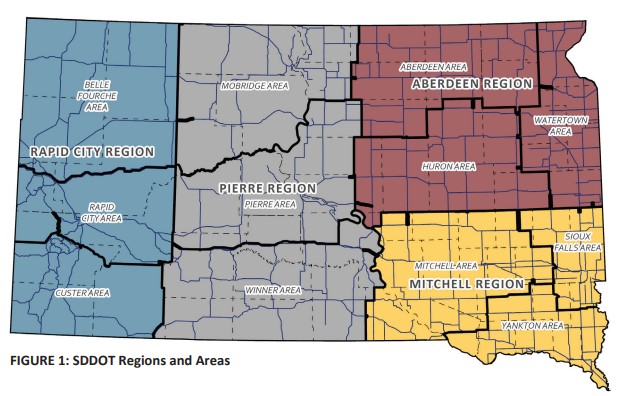SIOUX FALLS, S.D. (KELO) — The South Dakota Department of Transportation has 394 full-time snow plows, 23 road graders with V-plows, 105 snow blowers, 26 tow plows and 51 spare snow plows.
Where is all that equipment located? It’s divided between the four regional districts of Rapid City, Pierre, Aberdeen and Mitchell, according to the SDDOT 2024-2025 winter maintenance plan.

The Rapid City region includes stations in Custer and Belle Fourche with 94 total plows/sanders and 19 spares. The district has 69 permanent operators, 12 seasonal operators and 27 in reserve.
The Pierre region includes stations in Winner and Mobridge. The district has 84 total plows/sanders and 12 spares. There are 77 permanent operators, two seasons and 11 reserves.
The Aberdeen region includes stations in Watertown and Huron. The district has 103 plows/sanders and nine pares. It has 79 permanent operators, 10 seasonal operators and 15 reserves.
The Mitchell region includes stations in Sioux Falls and Yankton. It has 113 plows/sanders and 10 spares. The district has 87 permanent operators, 19 seasonal and 39 reserves.
What about the breakdown within the district?
The Mitchell region has the most operators and equipment. Of its 113 plows/sanders, 41 are based in Sioux Falls. That station has 29 permanent operators, 13 seasonal and seven reserves.
The Mitchell site has 39 plows/sanders and eight spares. It has 36 permanent operators, one season and 13 reserves.
Yankton has 33 plows/sanders and two spares, 22 permanent operators, five seasonal and 19 reserves.
The Aberdeen district has 34 plows/sanders in Aberdeen with three spares. There are 27 permanent employees with one reserve.
Watertown has 40 plows/sanders, five spares, 29 permanent operators, six seasonal and nine reserves. Huron has 29 plows/sanders, one spare, 23 permanent operators, four season and five reserves.
In the Pierre region, Winner has 36 plows/sanders with four spares. It has 36 permanent operators with six reserve.
Pierre has 23 plows/sanders with five spares. It has 19 full-time operators with two reserves. Mobridge 25 plows/sanders with four spares. It has 22 permanent operators, two seasonal and three reserve.
The breakdown for Rapid city Belle Fourche 30 plows/sanders 5 spares, 22 permanent operators and 4 season and 11 reserve.
Rapid City has 41 plows/sanders five spares, 27 permanent operators, five seasonal and 11 reserves. Custer 23 plows/sanders, eight spares. 20 permanent operators, three seasonal and five reserves.
How close are you to a priority route?
The SDDOT lists interstates as priority routes for snow removal which means when equipment is operating. These routes get coverage once every two hours during operation.
Examples of priority routes in the Rapid City region include U.S. Highway 16, U.S. Highway 85 and South Dakota Highway 79.
Most of the priority routes in the Pierre and Aberdeen region are U.S. Highways that travel across both regions such as U.S. Highway 14 and U.S. Highway 12 and U.S. Highway 212.
Sections of South Dakota Highway 34 and South Dakota Highway 37 are examples of priority routes in the Mitchell district.
The state has 24-hour routes on sections of I-90 in Rapid City and Sioux Falls and a section of I-29 in Sioux Falls.
I-29 is an extended hour route from the border with Iowa up to the exit for U.S. Highway 14. There are sections of extended-hour routes in Rapid City.
What’s 36-foot long and moves snow?
The SD DOT started testing tow plows on interstates in Sioux Falls during the 2016-2017 winter season. Three new tow plows were added to the snow removal arsenal in November of 2017.
Tow plows are a 36-foot snow removal trailer pulled by a snowplow truck and, along with the front plow on the truck, can clear widths up to 25 feet. The operator can remove snow from one lane and the shoulder in one pass, according to the SD DOT.
The state has 26 tow plows for the 2024-2025 winter season.
The SD DOT said in its recent winter maintenance report that tow plows are used on interstates and four-lane expressways where they are most efficient.
Tow plows are located in 17 cities.
Which region needs a lot of de-icing chemicals?
The Rapid City region often has heavy snowfall, wet and freezing roads and regular wind. The SD DOT says that often requires daily maintenance for weeks. It can also create a need for higher volumes of de-icing chemicals.
De-icing chemicals are less effective in the Aberdeen region. The region is the coldest of the four and those cold temperatures make de-icing chemicals less effective.
Those who live in the southern part of the Pierre region may notice that it gets heavier, wetter snow than the northern part. Blowing snow is common in the entire region.
The I-90 bridge at Chamberlain can get thick layers of ice during the winter. Generally, the southern part of the region will get less snow than the north.

